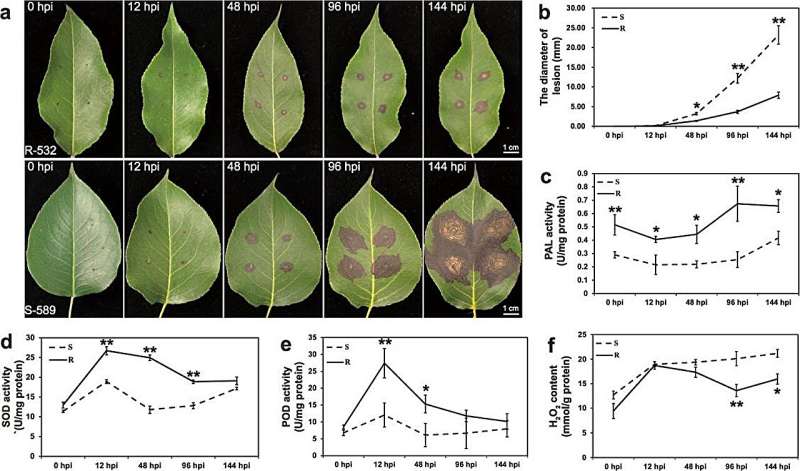This article has been reviewed according to Science X's editorial process and policies. Editors have highlighted the following attributes while ensuring the content's credibility:
fact-checked
peer-reviewed publication
trusted source
proofread
The role of PbrChiA chitinase in ROS regulation and antifungal activity

Pear ring rot, a significant threat to pear production, is caused by Botryosphaeria dothidea, leveraging the complex dynamics of reactive oxygen species (ROS) during infection. Initially, plants employ their innate immune system, detecting pathogens through conserved molecular patterns and triggering a defense mechanism that includes ROS bursts, restricting pathogen growth.
However, B. dothidea thrives in the later necrotrophic infection stage by exploiting high ROS levels for proliferation. The current challenge lies in understanding how plants manage ROS levels to maintain resistance against B. dothidea without facilitating its growth.
In September 2023, Horticulture Research published research titled "PbrChiA: a key chitinase of pear in response to Botryosphaeria dothidea infection by interacting with PbrLYK1b2 and down-regulating ROS accumulation."
In this study, researchers employed comparative transcriptome analysis to delve into the molecular dynamics of pear resistance to Botryosphaeria dothidea infection, pinpointing chitinase PbrChiAas a crucial regulator. By contrasting susceptible and resistant pear cultivars, the research unveiled that PbrChiA not only exhibits direct antifungal activity but also mitigates chitin-induced ROS accumulation by interacting with PbrLYK1b2, thereby enhancing pear's defense mechanisms.
The analysis spanned early to later stages of infection, revealing a distinct upregulation of defense-related genes and pathways, such as photosynthesis inhibition and MAPK signaling, in the resistant cultivar, alongside heightened enzyme activities and reduced ROS levels, contributing to its resilience.
The research further confirmed the functionality of PbrChiA through various assays, including chitin-binding, antifungal activities, and ectopic expression in Arabidopsis, which solidified its role in suppressing ROS and bolstering resistance. Interaction studies highlighted the symbiotic relationship between PbrChiA and PbrLYK1b2, suggesting a novel mechanism where this interaction curbs ROS accumulation, which is pivotal for the plant's defense strategy.
Additionally, the study explored the effects of PbrChiA and PbrLYK1b2 overexpression in pear callus, demonstrating enhanced resistance to B. dothidea through modulated enzyme activities and ROS levels.
Overall, this research not only sheds light on PbrChiA's dual functionality in antifungal defense and ROS management but also opens avenues for further exploration into the evolutionary adaptability of chitinases and their potential in crafting robust fungal resistance strategies in crops.
More information: Qiming Chen et al, PbrChiA: a key chitinase of pear in response to Botryosphaeria dothidea infection by interacting with PbrLYK1b2 and down-regulating ROS accumulation, Horticulture Research (2023). DOI: 10.1093/hr/uhad188
Journal information: Horticulture Research
Provided by NanJing Agricultural University




















